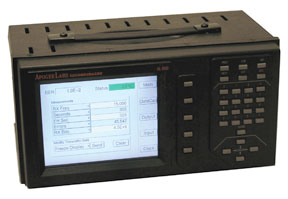Search Case Studies
End-Use Case Study
- EMI Shielding Compounds Make Telemetry Equipment More Lightweight and Cost Efficient

“Our products can be thought of as ‘Fed Ex’ for bits,” explained Shane Woolridge, Vice President of Marketing and Sales at Apogee Labs. “They are designed to transport, test, convert and record all types of data in a fast and efficient manner.”
Apogee’s telemetry products are continually evolving to satisfy the specialty needs of its high-tech customers. One example is a new instrument, the AL6500, used for testing bit error rates and data links on satellite displays and rocket launches.
Typically, such testing equipment is permanently rack-mounted and more or less stationary. But the new ground-breaking AL6500 is Apogee Labs’ first tester that is portable. Therefore, it had to be more compact (the size of a lunchbox) and weigh less than its predecessors that were constructed out of metal. To accomplish this, Apogee decided — for the first time — to design the outer case using a thermoplastic.
Radiated electromagnetic signals are a concern of testing equipment and a primary factor when making a material change to the design. The thermoplastic compound must exhibit electromagnetic compatibility (EMC) to ensure that nuisance electronic “noise” is not released into the environment.
RTP Company was selected as the material supplier. Chosen as the molder was Protomold, a leading rapid injection molding company based in Maple Plain, Minnesota. Meeting property requirements for the application was critical. The compound had to be capable of providing high strength and impact resistance, but also ensure electromagnetic and radio frequency interference (EMI/RFI) protection.
“Molding this type of conductive, EMI Shielding Compound was a first for us,” said Kevin Crystal, Senior Quality Engineer at Protomold. “We have always had a good relationship with RTP Company and their excellent support is a known factor from our past programs. We knew the RTP advice would be appropriate.”
RTP Company engineered an RTP 300 Series polycarbonate compound containing stainless steel fibers that provide protection against EMI/RFI, as well as giving strong electrostatic dissipation performance. In addition, it exceeds needed impact requirements and has a flammability rating of V-0 to meet the UL certification.
Not only did the RTP 300 Series polycarbonate EMI Shielding Compound allow the AL6500 to be a lighter weight than the earlier metal-housed models, the use of thermoplastic material gave the design freedom needed to build in a much smaller footprint. This combination worked synergistically with Apogee’s new electronic designs to dramatically lower the cost to their telemetry customers. These benefits, inherent in thermoplastic materials, are expected to take the test equipment from a small niche market to a much wider audience.
“This has been a flagship product for us,” said Woolridge. “It has been extremely well received and our telemetry customers in the NASA, aerospace, and military markets are enthusiastic about it, ordering high volumes. Now, because of its lower cost and portability, we may be able it to take to the mainstream communication market.”
Apogee Labs, Inc. engineers state-of-the-art products for the communications, instrumentation and telemetry communities. Apogee bridges the gaps that exist between the unique requirements of the DoD National Test Ranges, NASA, the High Energy Physics communities and commercial communications and networking infrastructures. www.apogeelabs.com.
The Protomold Company, Inc. has radically changed the economics and lead times associated with prototype and low-volume production of injection molded parts. Its defined market segment, rapid injection molding, is positioned between rapid prototyping and conventional high volume injection molding. www.protomold.com.




